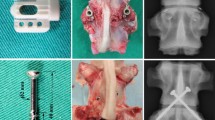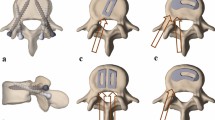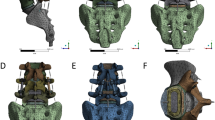Abstract
Purpose
Purpose of this paper is to evaluate the primary stability of a new approach for facet fixation the so-called Facet Wedge (FW) in comparison with established posterior fixation techniques like pedicle screws (PS) and translaminar facet screws (TLS) with and without anterior cage interposition.
Methods
Twenty-four monosegmental fresh frozen non-osteoporotic human motion segments (L2–L3 and L4–L5) were tested in a two-arm biomechanical study using a robot-based spine tester. Facet Wedge was compared with pedicle screws and translaminar screws as a stand-alone device and in combination with an anterior fusion cage.
Results
Pedicle screws, FW and translaminar screws could stabilize an intact motion segment effectively. Facet Wedge was comparable to PS for lateral bending, extension and flexion and slightly superior for axial rotation. Facet Wedge showed a superior kinematic capacity compared to translaminar screws.
Conclusions
Facet Wedge offers a novel posterior approach in achieving primary stability in lumbar spinal fixation. The results of the present study showed that the Facet Wedge has a comparable primary stability to pedicle screws and potential advantages over translaminar screws.





Similar content being viewed by others
References
Kim DH, Albert TJ (2002) Update on use of instrumentation in lumbar spine disorders. Best Pract Res Clin Rheumatol 16(1):123–140
Gaines RW Jr (2000) The use of pedicle-screw internal fixation for the operative treatment of spinal disorders. J Bone Joint Surg Am 82-A(10):1458–1476
Gelalis ID, Paschos NK, Pakos EE, Politis AN, Arnaoutoglou CM, Karageorgos AC, Ploumis A, Xenakis TA (2012) Accuracy of pedicle screw placement: a systematic review of prospective in vivo studies comparing free hand, fluoroscopy guidance and navigation techniques. Eur Spine J 21(2):247–255. doi:10.1007/s00586-011-2011-3
Idler C, Rolfe KW, Gorek JE (2010) Accuracy of percutaneous lumbar pedicle screw placement using the oblique or “owl’s-eye” view and novel guidance technology. J Neurosurg Spine 13(4):509–515
King D (1944) Internal fixation for lumbosacral fusion. J Bone Joint Surg Am 30A(3):560–565
Boucher HH (1959) A method of spinal fusion. J Bone Joint Surg Br 41B(2):248–259
Agarwala A, Bucklen B, Muzumdar A, Moldavsky M, Khalil S (2012) Do facet screws provide the required stability in lumbar fixation? A biomechanical comparison of the Boucher technique and pedicular fixation in primary and circumferential fusions. Clin Biomech (Bristol, Avon) 27(1):64–70
Marchesi DG, Boos N, Zuber K, Aebi M (1992) Translaminar facet joint screws to enhance segmental fusion of the lumbar spine. Eur Spine J 1(2):125–130
Park YK, Chung HS (1999) Instrumented facet fusion for the degenerative lumbar disorders. Acta Neurochir (Wien) 141(9):915–920
Park YK, Kim JH, Oh JI, Kwon TH, Chung HS, Lee KC (2002) Facet fusion in the lumbosacral spine: a 2-year follow-up study. Neurosurgery 51(1):88–95
Magerl FP (1984) Stabilization of the lower thoracic and lumbar spine with external skeletal fixation. Clin Orthop Relat Res 189:125–141
Aepli M, Mannion AF, Grob D (2009) Translaminar screw fixation of the lumbar spine: long-term outcome. Spine 34(14):1492–1498
Beaubien BP, Mehbod AA, Kallemeier PM, Lew WD, Buttermann GR, Transfeldt EE, Wood KB (2004) Posterior augmentation of an anterior lumbar interbody fusion: minimally invasive fixation versus pedicle screws in vitro. Spine 29(19):E406–E412
Kandziora F, Schleicher P, Scholz M, Pflugmacher R, Eindorf T, Haas NP, Pavlov PW (2005) Biomechanical testing of the lumbar facet interference screw. Spine 30(2):E34–E39
Rohlmann A, Neller S, Claes L, Bergmann G, Wilke HJ (2001) Influence of a follower load on intradiscal pressure and intersegmental rotation of the lumbar spine. Spine 26(24):E557–E561
Schulze M, Hartensuer R, Gehweiler D, Holscher U, Raschke MJ, Vordemvenne T (2012) Evaluation of a robot-assisted testing system for multisegmental spine specimens. J Biomech 45(8):1457–1462
Wilke HJ, Wenger K, Claes L (1998) Testing criteria for spinal implants: recommendations for the standardization of in vitro stability testing of spinal implants. Eur Spine J 7(2):148–154
Jeanneret B, Kleinstück F, Magerl F (1995) Translaminar screw fixation of the lumbar facet joints. Orthop Traumatol 4(1):37–53
Rohlmann A, Zander T, Bergmann G (2005) Comparison of the biomechanical effects of posterior and anterior spine-stabilizing implants. Eur Spine J 14(5):445–453. doi:10.1007/s00586-004-0784-3
Wang XY, Dai LY, Xu HZ, Chi YL (2008) Biomechanical effect of the extent of vertebral body fracture on the thoracolumbar spine with pedicle screw fixation: an in vitro study. J Clini Neurosci 15(3):286–290
Razi AE, Spivak JM, Kummer FJ, Hersh DS, Goldstein JA (2011) Biomechanical comparison of translaminar screw versus pedicle screw supplementation of anterior femoral ring allografts in one-level lumbar spine fusion. Bull NYU Hosp Joint Dis 69(4):298–302
Oxland TR, Lund T (2000) Biomechanics of stand-alone cages and cages in combination with posterior fixation: a literature review. Eur Spine J 9(Suppl 1):S95–S101
Chen SH, Mo Lin R, Chen HH, Tsai KJ (2007) Biomechanical effects of polyaxial pedicle screw fixation on the lumbosacral segments with an anterior interbody cage support. BMC Musculoskelet Disord 10(8):28
Masharawi Y, Rothschild B, Salame K, Dar G, Peleg S, Hershkovitz I (2005) Facet tropism and interfacet shape in the thoracolumbar vertebrae: characterization and biomechanical interpretation. Spine 30(11):E281–E292
Su BW, Cha TD, Kim PD, Lee J, April EW, Weidenbaum M, Albert TJ, Vaccaro AR (2009) An anatomic and radiographic study of lumbar facets relevant to percutaneous transfacet fixation. Spine 34(11):E384–E390
Acknowledgments
The authors would like to thank Synthes AG (Switzerland) for financial and material support, the German Society of Arthroscopy (AGA) for technical support, and Raquel Billiones for her support in editing this article.
Conflict of interest
There are no other relationships/conditions/circumstances that present a potential conflict of interest.
Author information
Authors and Affiliations
Corresponding author
Rights and permissions
About this article
Cite this article
Hartensuer, R., Riesenbeck, O., Schulze, M. et al. Biomechanical evaluation of the Facet Wedge: a refined technique for facet fixation. Eur Spine J 23, 2321–2329 (2014). https://doi.org/10.1007/s00586-014-3533-2
Received:
Revised:
Accepted:
Published:
Issue Date:
DOI: https://doi.org/10.1007/s00586-014-3533-2




